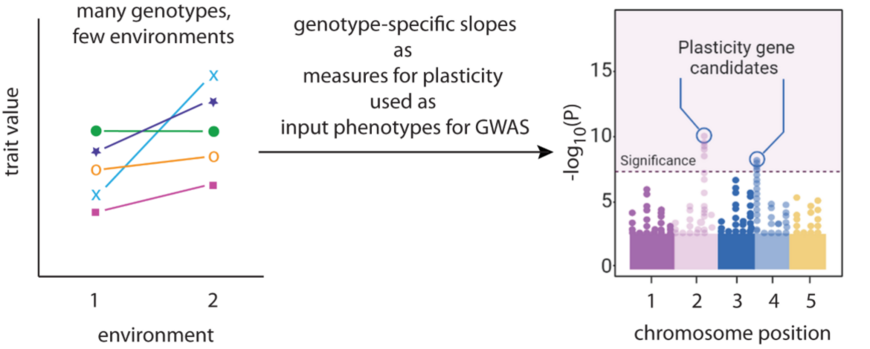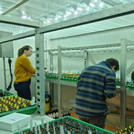Collaborative Research Centre: Phenotypic plasticity in plants-Mechanisms, constraints and evolution
The Collaborative Research Centre (CRC) 1644, "Phenotypic plasticity in plants – Mechanisms, constraints and evolution," brings together expertise from multiple institutions to investigate the genetic and molecular basis of phenotypic plasticity in plants. Running from 2024 to 2027, this collaborative effort aims to uncover the fundamental principles governing plant adaptability and evolution.
Within this framework, Project B03 focuses on understanding how genetic and functional mechanisms underpin the reaction norms of the leaf economics spectrum (LES) across varying environmental gradients. This project explores the interplay between genotype and environment in shaping plant traits related to resource acquisition and conservation.
Have a look at the official website for more details: Collaborative Research Centre 1644 - University of Potsdam
Mission
The primary goals of the Collaborative Research Centre (CRC) 1644 encompass four main aspects:
- Investigate the genetic and molecular mechanisms driving phenotypic plasticity in plants, aiming to understand how plants adapt to diverse environmental conditions.
- Uncover the constraints and evolutionary dynamics that influence plant adaptability, providing insights into how plants can survive and thrive amidst changing climates.
- Foster interdisciplinary collaboration among experts in plant genetics, ecology, and developmental biology to integrate diverse perspectives and approaches in plant research.
- Develop innovative methodologies and approaches for studying plant responses to environmental changes, enhancing our ability to predict and manage plant behavior in natural and agricultural systems.
Our working group is participating in the CRC1644with project B3: Genomic and functional underpinning of reaction norms across environmental gradients, in which we study the phenotypic plasticity of various populations of the model plant Arabidopsis thaliana under environmental stress and to find the genetic basis of the dissimilarities and distinct responses shown in their reaction norms.
Opportunities
You are welcome to inquire about possibilities for PhD or post-doctoral positions. Please check vacant positions or contact Prof. A. Linstädter (linstaedter@uni-potsdam.de) directly. Should you seek opportunities for a Bachelor or Master thesis, please check our institutional list of topic for theses.
Genomic and functional underpinning of reaction norms across environmental gradients
Aims | The project B3 aims to investigate the genetic basis of variation in LES (Leaf Economic Spectrum) traits among different species, analyse the functional relationships between LES traits and environmental conditions, and study the evolutionary and ecological implications of LES trait variability. |
Approach | We will conduct extensive field sampling across diverse environments to collect data on LES traits, perform genomic sequencing and trait analysis on the collected samples, and utilize statistical models to identify genetic loci associated with LES traits and their response to environmental gradients. |
Expected Outcome | The project aims to provide insights into plant adaptation strategies, aiding in the development of resilient crops and better management of natural ecosystems. Understanding the genomic and functional mechanisms underlying LES variation will contribute to our knowledge of plant ecology and evolution in the face of environmental changes. |
Persons Involved
| PIs PostDoc Dr. Vera Hesen
|
Cooperation partners | Leibniz Institute of Genetics and Crop Plant Research (IPK), Gatersleben Max Planck Institute of Molecular Plant Physiology (MPI-MP), Potsdam Leibniz Institute of Vegetable and Ornamental Crops (IGZ), Großbeeren Humboldt Universität, Berlin |
Outreach | A. A. Agrawal, A scale-dependent framework for trade-offs, syndromes, and specialization in organismal biology. Ecology 101, e02924 (2020). A. C. Westerband, J. L. Funk, K. E. Barton, Intraspecific trait variation in plants: a renewed focus on its role in ecological processes. Ann. Bot. 127, 397-410 (2021). A. Estarague et al., Into the range: a latitudinal gradient or a center-margins differentiation of ecological strategies in Arabidopsis thaliana? Ann. Bot. 129, 343-356 (2022). A. Fajardo, A. Siefert, Intraspecific trait variation and the leaf economics spectrum across resource gradients and levels of organization. Ecology 99, 1024-1030 (2018). A. Weigelt et al., An integrated framework of plant form and function: the belowground perspective. New Phytol. 232, 42-59 (2021). C. M. Lorts, J. R. Lasky, Competition× drought interactions change phenotypic plasticity and the direction of selection on Arabidopsis traits. New Phytol. (2020). Project B3 Linstädter, Lenhard F. Vasseur et al., Climate as a driver of adaptive variations in ecological strategies in Arabidopsis thaliana. Annals in Botany 122, 935–945 (2018). G. Schmitz et al., Local adaptation of life-history traits within urban populations of Arabidopsis thaliana. bioRxiv, 2022.2010. 2003.510679 (2022). H. Bruelheide et al., Global trait–environment relationships of plant communities. Nature ecology & evolution 2, 1906-1917 (2018). H. W. Polley, H. P. Collins, P. A. Fay, Community leaf dry matter content predicts plant production in simple and diverse grassland. Ecosphere 13, e4076 (2022). I. J. Wright et al., The worldwide leaf economics spectrum. Nature 428, 821-827 (2004). J. M. Craine, Reconciling plant strategy theories of Grime and Tilman. J. Ecol. 93, 1041-1052 (2005). J. P. Grime, Evidence for the existence of three primary strategies in plants and its relevance to ecological and evolutionary theory. Am. Nat. 111, 1169-1194 (1977). J. S. Joswig et al., Climatic and soil factors explain the two-dimensional spectrum of global plant trait variation. Nature Ecology & Evolution 6, 36-50 (2022). J. Yu et al., Variation of plant CSR strategies across a precipitation gradient in the alpine grasslands on the northern Tibet Plateau. Sci. Total Environ. 838, 156512 (2022). K. Grigulis et al., Relative contributions of plant traits and soil microbial properties to mountain grassland ecosystem services. J. Ecol. 101, 47-57 (2013). K. Sartori et al., Leaf economics and slow-fast adaptation across the geographic range of Arabidopsis thaliana. Scientific Reports 9, 1-12 (2019). L. D. Gorné et al., The acquisitive-conservative axis of leaf trait variation emerges even in homogeneous environments. Ann. Bot. (2020). M. Westoby, A leaf-height-seed (LHS) plant ecology strategy scheme. Plant and Soil 199, 213-227 (1998). D. Tilman, Resources: a graphical-mechanistic approach to competition and predation. Am. Nat. 116, 362-393 (1980). P. B. Reich, M. Walters, D. Ellsworth, Leaf life‐span in relation to leaf, plant, and stand characteristics among diverse ecosystems. Ecol. Monogr. 62, 365-392 (1992). P. Clauw et al., Leaf growth response to mild drought: natural variation in Arabidopsis sheds light on trait architecture. The Plant Cell 28, 2417-2434 (2016). R.-L. May, S. Warner, A. Wingler, Classification of intra-specific variation in plant functional strategies reveals adaptation to climate. Ann. Bot. 119, 1343-1352 (2017). S. Díaz et al., The global spectrum of plant form and function. Nature 529, 167-171 (2016). S. Díaz et al., The plant traits that drive ecosystems: evidence from three continents. J. Veg. Sci. 15, 295-304 (2004). W. Ji, S. E. LaZerte, M. J. Waterway, M. J. Lechowicz, Functional ecology of congeneric variation in the leaf economics spectrum. New Phytol. 225, 196-208 (2020). |



